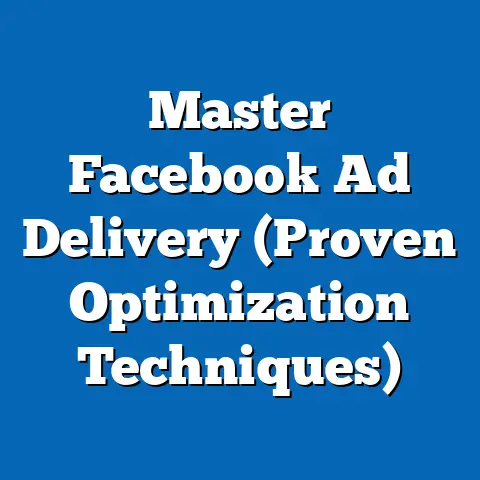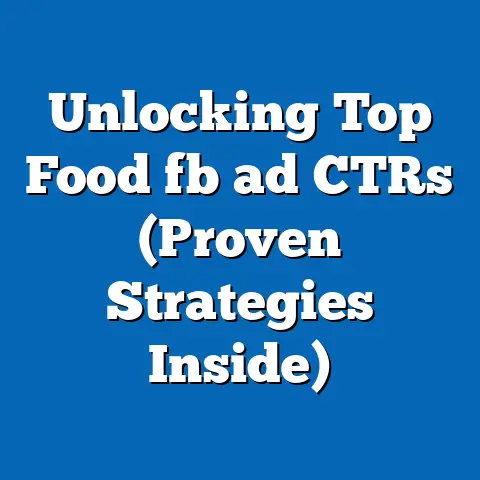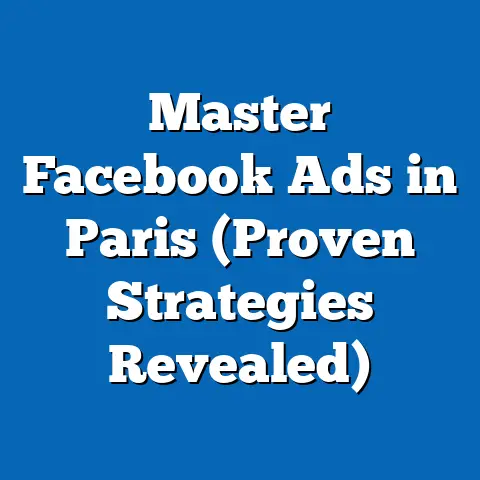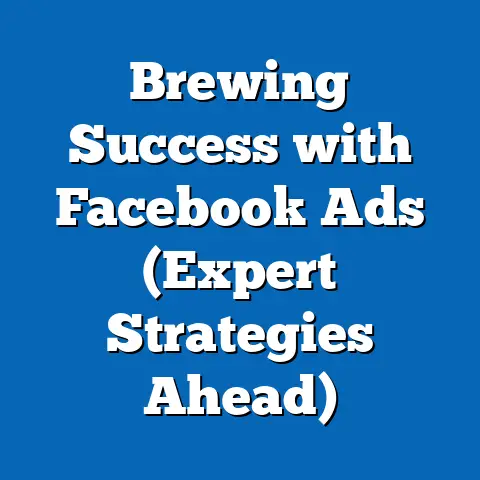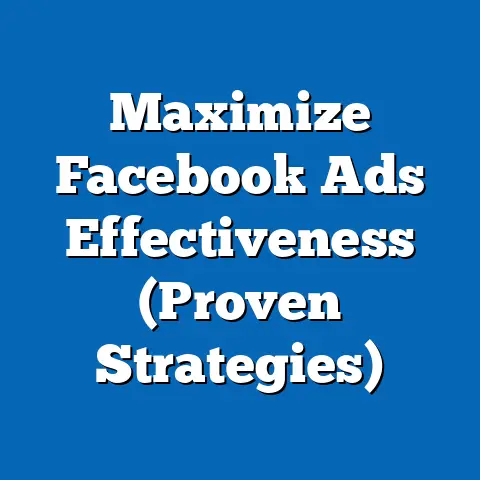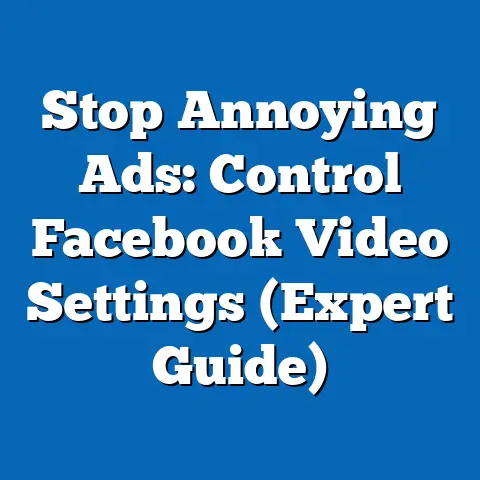Optimal Facebook Picture Ad Size (Must-Know Insights)
Have you ever felt the frustration of meticulously crafting a Facebook ad, only to see it displayed in a distorted, cropped, or downright unflattering way? I know I have. It’s a common pain point for marketers and business owners alike. You pour your heart and soul into creating compelling visuals, only to have Facebook butcher them because the image size isn’t quite right. The result? Wasted ad spend, a lack of engagement, and a feeling that your message just isn’t landing.
Think about it: in a world of endless scrolling, your ad has mere seconds to grab attention. A pixelated or strangely cropped image isn’t going to cut it. It screams “unprofessional” and can instantly turn potential customers away. In fact, studies have shown that ads with high-quality visuals have a significantly higher click-through rate (CTR) than those with poorly sized or low-resolution images. Some reports suggest a difference of up to 30%!
I remember one particular campaign I ran for a local bakery. We had this gorgeous photo of their signature cake, but I didn’t pay close enough attention to the Facebook ad specs. The result? The top of the cake was cut off, making it look like a strange, headless dessert. It was embarrassing, and the ad performed terribly.
The Importance of Ad Size in Facebook Advertising
Why does ad size matter so much? It’s a question I get asked frequently, and the answer is multi-faceted. At its core, successful advertising is about capturing attention and conveying a message effectively. Visual appeal plays a critical role in this process.
The Role of Visual Appeal
Imagine walking down a busy street lined with shops. Which storefronts grab your attention? The ones with well-designed displays, eye-catching signs, and a clear, inviting message, right? Facebook advertising is no different. Your ad is competing for attention in a crowded newsfeed, and the visual element is often the first thing people notice.
The right image size can significantly impact your click-through rate (CTR) and overall ad performance in several ways:
- First Impressions: A well-sized image creates a positive first impression. It tells users that you’re professional, detail-oriented, and care about the quality of your brand.
- Clarity: The correct dimensions ensure your image is clear and easy to understand. Users can quickly grasp the message and value proposition.
- Engagement: Visually appealing ads are more likely to capture attention and encourage users to click, like, comment, or share.
- Brand Recognition: Consistent use of properly sized and branded images helps reinforce your brand identity and build recognition over time.
Facebook’s Advertising Guidelines
Facebook has specific policies regarding image sizes and dimensions to ensure a consistent and high-quality user experience. These guidelines are not arbitrary; they are designed to optimize the display of ads across various devices and platforms. Ignoring these guidelines can lead to:
- Ad Rejection: Your ad may be rejected by Facebook if it doesn’t meet the specified size requirements. This can delay your campaign launch and waste valuable time.
- Poor Display: Even if your ad is approved, it may appear distorted, cropped, or pixelated, negatively impacting its visual appeal.
- Reduced Reach: Facebook’s algorithm may penalize ads with poor image quality, limiting their reach and visibility.
Staying up-to-date with Facebook’s advertising guidelines is crucial. I recommend checking the official Facebook Ads Help Center regularly for the latest specifications. These guidelines can change, so it’s essential to stay informed.
User Experience is Key
Ultimately, the success of your Facebook ads hinges on providing a positive user experience. Ads that appear distorted or improperly cropped can frustrate users and lead to negative perceptions of your brand. Think about it: would you trust a company whose ads look sloppy and unprofessional? Probably not.
A good user experience means:
- Easy-to-Read Ads: Images should be clear, concise, and easy to understand, even on small screens.
- Fast Loading Times: Ads should load quickly to avoid frustrating users who are scrolling through their feed.
- Relevant Content: Images should be relevant to the ad copy and target audience.
- Seamless Integration: Ads should seamlessly integrate into the user’s newsfeed without being disruptive or annoying.
Key Takeaway: Ad size is not just a technical detail; it’s a crucial element of visual appeal, user experience, and overall ad performance. Adhering to Facebook’s advertising guidelines and prioritizing image quality are essential for creating successful Facebook ads.
Next Step: Familiarize yourself with Facebook’s advertising guidelines and the specific image size requirements for different ad types.
Detailed Breakdown of Optimal Facebook Picture Ad Sizes
Now, let’s get into the nitty-gritty of optimal Facebook picture ad sizes. Facebook offers a variety of ad formats, each with its own unique specifications. Understanding these differences is crucial for creating ads that look their best and perform effectively.
Here’s a comprehensive overview of the most common ad types and their recommended image sizes:
1. Single Image Ads
Single image ads are the workhorses of Facebook advertising. They’re simple, versatile, and effective for a wide range of marketing goals.
- Recommended Image Dimensions: 1200 x 628 pixels
- Aspect Ratio: 1.91:1
- Minimum Width & Height: 600 pixels
- Recommended File Type: JPG or PNG
- Maximum File Size: 30MB
Best Practices:
- Use High-Quality Images: Avoid pixelated or blurry images.
- Keep Text to a Minimum: Facebook recommends limiting text to 20% of the image.
- Use Compelling Visuals: Choose images that are relevant to your target audience and grab their attention.
- Test Different Images: Experiment with different visuals to see what resonates best with your audience.
Example:
Imagine you’re advertising a new line of athletic shoes. A single image ad could feature a close-up shot of the shoes being worn during a workout, showcasing their design and functionality. The ad copy could highlight the shoes’ key features and benefits, along with a call to action to “Shop Now.”
2. Carousel Ads
Carousel ads allow you to showcase multiple images or videos within a single ad unit. This format is ideal for telling a story, highlighting different products, or showcasing various features of a single product.
- Recommended Image Dimensions: 1080 x 1080 pixels
- Aspect Ratio: 1:1 (Square)
- Minimum Width & Height: 600 pixels
- Recommended File Type: JPG or PNG
- Maximum File Size: 30MB per image
- Number of Cards: 2-10
Best Practices:
- Use Consistent Branding: Ensure all images have a consistent look and feel.
- Tell a Story: Use the carousel format to guide users through a narrative or showcase a product’s evolution.
- Highlight Key Features: Use each card to highlight a specific feature or benefit.
- Include a Strong Call to Action: Encourage users to click through to your website or landing page.
Example:
A travel agency could use a carousel ad to showcase different destinations, with each card featuring a stunning image of a different location, along with a brief description and a call to action to “Book Now.”
3. Slideshow Ads
Slideshow ads are a cost-effective way to create engaging video-like content using static images. They’re perfect for businesses with limited video resources.
- Recommended Image Dimensions: 1280 x 720 pixels (16:9 aspect ratio) or 1080 x 1080 pixels (1:1 aspect ratio)
- Aspect Ratio: 16:9 or 1:1
- Minimum Width & Height: 600 pixels
- Recommended File Type: JPG or PNG
- Maximum File Size: 30MB per image
Best Practices:
- Use High-Quality Images: Choose images that are visually appealing and relevant to your message.
- Add Music or Voiceover: Enhance the slideshow with music or a voiceover to make it more engaging.
- Keep it Short and Sweet: Aim for a slideshow length of 15-30 seconds.
- Include a Clear Call to Action: Tell users what you want them to do after watching the slideshow.
Example:
A furniture store could use a slideshow ad to showcase different room settings, with each image featuring a different combination of furniture and decor. The slideshow could be set to upbeat music and include a call to action to “Shop the Look.”
4. Collection Ads
Collection ads are designed to showcase products in a visually appealing and interactive way. They typically feature a hero image or video at the top, followed by a grid of related products below.
- Recommended Image Dimensions (Hero Image): 1200 x 628 pixels
- Recommended Video Dimensions (Hero Video): 1200 x 628 pixels or 1080 x 1080 pixels
- Aspect Ratio: 1.91:1 (for hero image) or 1:1 (for hero video)
- Minimum Width & Height: 600 pixels
- Recommended File Type: JPG or PNG (for hero image)
- Recommended Video Format: MP4 or MOV (for hero video)
- Maximum File Size: 30MB (for hero image) or 4GB (for hero video)
Best Practices:
- Use High-Quality Visuals: Choose a hero image or video that is visually stunning and relevant to your products.
- Showcase a Variety of Products: Include a diverse range of products in the grid below.
- Optimize for Mobile: Collection ads are designed for mobile devices, so ensure they look great on smaller screens.
- Use Instant Experience: Consider using Facebook’s Instant Experience feature to create a full-screen, immersive shopping experience.
Example:
A clothing retailer could use a collection ad to showcase their latest collection, with a hero image featuring a model wearing the new clothes and a grid of related products below, such as shirts, pants, and accessories.
Common Misconceptions
One of the most common misconceptions I encounter is that any image can be used for Facebook ads, regardless of its size or dimensions. This is simply not true. While Facebook may allow you to upload images that don’t meet the recommended specifications, they will often be cropped, distorted, or pixelated, resulting in a poor user experience.
Another misconception is that image size doesn’t matter as long as the file size is small. While file size is important for loading times, it’s not a substitute for proper image dimensions. A small file size won’t fix a poorly sized or low-resolution image.
Key Takeaway: Each ad type on Facebook has its own unique image size requirements. Adhering to these specifications is crucial for creating visually appealing and effective ads.
Next Step: Create a cheat sheet with the recommended image sizes for each ad type and keep it handy when creating your Facebook ads.
The Impact of Image Quality on Ad Performance
While image size is important, image quality is equally crucial. A perfectly sized image that is pixelated, blurry, or poorly lit will still perform poorly.
Resolution and Visibility
Image resolution refers to the number of pixels in an image. The higher the resolution, the more detail the image contains. Low-resolution images appear pixelated and blurry, especially when viewed on larger screens.
High-resolution images, on the other hand, are sharp, clear, and visually appealing. They capture attention and convey a sense of professionalism.
Facebook recommends using images with a resolution of at least 72 DPI (dots per inch) for optimal visibility. However, I recommend using images with a resolution of 300 DPI whenever possible, especially for images that will be printed or displayed on large screens.
File Size and Loading Times
File size refers to the amount of storage space an image occupies on your computer. Large file sizes can lead to slow loading times, which can frustrate users and increase bounce rates.
Facebook recommends keeping file sizes below 30MB for images and 4GB for videos. However, I recommend aiming for even smaller file sizes whenever possible, especially for mobile ads.
You can reduce file sizes by:
- Compressing Images: Use image compression tools like TinyPNG or ImageOptim to reduce file sizes without sacrificing too much quality.
- Optimizing Images for Web: Use image editing software like Photoshop or GIMP to optimize images for web display.
- Choosing the Right File Format: JPG is generally the best file format for photographs, while PNG is better for graphics with sharp lines and text.
Case Studies: Successes and Failures
I’ve seen firsthand how image quality can make or break a Facebook ad campaign.
- Success Story: I worked with a local restaurant to create a Facebook ad campaign featuring high-resolution photos of their signature dishes. The images were so mouthwatering that they generated a significant increase in website traffic and online orders.
- Failure Story: I also worked with a small business that insisted on using low-resolution images for their Facebook ads. Despite my recommendations, they refused to invest in professional photography. The ads performed poorly, and the business blamed Facebook advertising for not working.
These examples highlight the importance of investing in high-quality visuals. While it may seem like an unnecessary expense, it can significantly impact your ad performance and ROI.
Key Takeaway: Image quality is just as important as image size. Use high-resolution images, optimize file sizes for fast loading times, and invest in professional photography when necessary.
Next Step: Audit your existing Facebook ads and replace any low-quality images with high-resolution alternatives.
Tailoring Your Images for Different Audiences
While adhering to Facebook’s image size guidelines and prioritizing image quality are essential, it’s also important to tailor your images for different audiences. What resonates with one demographic may not resonate with another.
Understanding Your Target Audience
Before creating any Facebook ads, it’s crucial to understand your target audience. This includes their demographics (age, gender, location, etc.), interests, behaviors, and pain points.
Once you have a clear understanding of your target audience, you can tailor your images to appeal to their specific preferences. For example:
- Younger Audiences: Use bright, vibrant colors and trendy visuals.
- Older Audiences: Use more sophisticated and timeless images.
- Luxury Brands: Use elegant and high-end visuals.
- Budget-Friendly Brands: Use relatable and down-to-earth images.
A/B Testing
A/B testing is a powerful way to determine what resonates best with your target audience. It involves creating two or more versions of an ad with different images and testing them against each other to see which performs better.
You can A/B test different:
- Image Sizes: Test different aspect ratios and dimensions.
- Image Styles: Test different colors, fonts, and layouts.
- Image Content: Test different visuals, such as product photos, lifestyle shots, or user-generated content.
Facebook’s Ads Manager makes it easy to set up A/B tests and track your results. By analyzing the data, you can identify the images that resonate best with your target audience and optimize your ad campaigns accordingly.
Cultural Considerations
Cultural differences can also affect image preferences and engagement rates. What is considered visually appealing in one culture may be offensive or inappropriate in another.
For example:
- Color Symbolism: Different colors have different meanings in different cultures.
- Imagery: Certain images may be considered taboo or disrespectful in some cultures.
- Language: Use appropriate language and translations for your target audience.
Before launching a Facebook ad campaign in a new market, it’s essential to research the local culture and adapt your images accordingly.
Key Takeaway: Tailoring your images for different audiences is crucial for maximizing engagement and ROI. Understand your target audience, A/B test different images, and consider cultural differences.
Next Step: Conduct audience research to understand the preferences of your target audience and create tailored images for your Facebook ads.
Future Trends in Facebook Advertising Image Sizes
The world of Facebook advertising is constantly evolving, and image sizes are no exception. As technology advances and user behavior changes, Facebook is likely to introduce new ad formats and update existing ones.
Emerging Technologies
Emerging technologies like augmented reality (AR) and virtual reality (VR) are likely to influence ad sizes in the future. AR ads, for example, may allow users to virtually try on clothes or place furniture in their homes. These ads will require different image sizes and formats than traditional Facebook ads.
VR ads, on the other hand, may immerse users in a virtual world where they can interact with products and services. These ads will require even more sophisticated image and video formats.
Facebook’s Evolving Platform
Facebook is constantly experimenting with new features and ad formats. As the platform evolves, marketers need to stay updated with changes to ad dimensions and formats.
I recommend following the Facebook Ads Help Center and industry blogs to stay informed about the latest changes. You should also be prepared to adapt your advertising strategies as needed.
The Importance of Flexibility
In the ever-changing world of Facebook advertising, flexibility is key. Marketers need to be able to quickly adapt to new ad formats, image sizes, and targeting options.
This requires:
- Continuous Learning: Stay up-to-date with the latest trends and best practices.
- Experimentation: Be willing to try new things and test different approaches.
- Data Analysis: Track your results and use data to inform your decisions.
By embracing flexibility and staying ahead of the curve, you can ensure your Facebook ads remain effective and engaging.
Key Takeaway: The world of Facebook advertising is constantly evolving. Stay updated with the latest trends, embrace emerging technologies, and be prepared to adapt your advertising strategies as needed.
Next Step: Subscribe to industry blogs and follow the Facebook Ads Help Center to stay informed about the latest changes in Facebook advertising.
I know it can seem like a lot to take in, but mastering these concepts is crucial for creating successful Facebook ads. Remember, the right image size can significantly impact your click-through rate, engagement, and overall ROI.
So, what are the key takeaways?
- Ad size is not just a technicality; it’s a fundamental aspect of visual appeal and user experience.
- Each ad type on Facebook has its own unique image size requirements.
- Image quality is just as important as image size.
- Tailoring your images for different audiences is crucial for maximizing engagement.
- The world of Facebook advertising is constantly evolving, so stay updated with the latest trends.
Now, it’s time to take action. Reassess your current Facebook ads and make any necessary adjustments based on the insights you’ve gained in this article. Check your image sizes, optimize your image quality, and tailor your visuals for your target audience.
Don’t let the frustration of poorly sized images hold you back from achieving your advertising goals. With a little bit of knowledge and effort, you can transform your Facebook ads from frustrating flops into high-performing successes.
What are you waiting for? Go out there and create some amazing Facebook ads!

